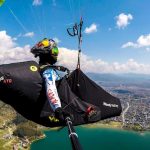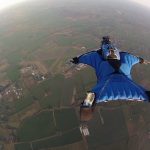Download links
How to install Soaring Through the Skies: The Thrill of Wingsuit Flying APK?
1. Tap the downloaded Soaring Through the Skies: The Thrill of Wingsuit Flying APK file.
2. Touch install.
3. Follow the steps on the screen.
Description
Wingsuit flying, a breathtaking blend of human ingenuity and the desire for flight, has its roots in the early 20th century. The concept of gliding through the air with a suit designed to enhance lift can be traced back to the pioneering work of aviators and inventors.
However, it wasn’t until the late 1990s that wingsuit flying began to gain popularity as a distinct sport. This resurgence was largely fueled by advancements in materials and design, which allowed for more effective and safer wingsuits. The modern era of wingsuit flying is often credited to the efforts of individuals like Patrick de Gayardon, who in the late 1990s pushed the boundaries of what was possible with wingsuits.
De Gayardon’s innovative designs and daring jumps showcased the potential of wingsuit flying, leading to a surge in interest among thrill-seekers and skydivers alike. By the early 2000s, wingsuit flying had evolved into a recognized sport, with dedicated competitions and events emerging around the world. The establishment of organizations such as the International Parachuting Commission (IPC) helped formalize the sport, setting rules and standards that would govern wingsuit flying competitions.
Key Takeaways
- Wingsuit flying originated from the early experiments of skydivers in the 1930s and has evolved into a popular extreme sport.
- The science behind wingsuit flying involves aerodynamics and the principles of lift and drag, allowing the flyer to glide through the air.
- The equipment needed for wingsuit flying includes a wingsuit, parachute, helmet, and altimeter to ensure safety and control during the flight.
- Training and skills required for wingsuit flying involve extensive skydiving experience, physical fitness, and mental focus to handle the high speeds and altitudes.
- The risks of wingsuit flying include the potential for mid-air collisions, equipment malfunctions, and the need for strict safety precautions to minimize danger, but the thrill and joy of wingsuit flying attract many enthusiasts to the sport.
The Science Behind Wingsuit Flying
At its core, wingsuit flying is a fascinating application of aerodynamics. The wingsuit itself is designed to create lift, allowing the wearer to glide through the air rather than simply falling. This is achieved through the use of fabric wings that extend between the arms and legs, effectively increasing the surface area of the body.
When a wingsuit flyer jumps from an aircraft, they enter a freefall state where gravity pulls them downward, but the design of the suit allows them to generate lift by manipulating airflow. The principles of lift and drag are crucial to understanding how wingsuit flying works. Lift is generated when air flows over and under the wingsuit, creating a pressure difference that allows the flyer to ascend or glide horizontally.
The angle of attack—the angle between the wing and the oncoming air—plays a significant role in determining how much lift is produced. A higher angle can increase lift but also increases drag, which can slow down the flyer. Thus, mastering the balance between these forces is essential for successful wingsuit flying.
Additionally, factors such as body position, speed, and environmental conditions all influence flight performance.
The Equipment Needed for Wingsuit Flying

Wingsuit flying requires specialized equipment that is distinct from traditional skydiving gear. The most critical component is, of course, the wingsuit itself. Modern wingsuits are crafted from lightweight, durable materials such as nylon or polyester, designed to withstand high speeds and turbulent air.
They come in various designs tailored for different types of flying—some are optimized for speed, while others prioritize maneuverability or gliding efficiency. The choice of wingsuit can significantly impact a flyer’s performance and experience. In addition to the wingsuit, a reliable parachute system is essential for safe landings.
Most wingsuit flyers use a specialized parachute designed for wingsuit flying, which typically features a larger canopy for better stability during deployment. A reserve parachute is also mandatory in case of emergencies. Other equipment includes an altimeter to monitor altitude during freefall and a jumpsuit that provides additional protection against cold temperatures at high altitudes.
Helmets equipped with cameras are popular among enthusiasts who wish to capture their flights, adding another layer of excitement to the experience.
The Training and Skills Required for Wingsuit Flying
| Training and Skills Required for Wingsuit Flying | |
|---|---|
| Physical fitness | Understanding of aerodynamics |
| Experience in skydiving | Knowledge of emergency procedures |
| Understanding of weather conditions | Training in proper body position |
| Knowledge of equipment and gear | Ability to assess and manage risks |
Before embarking on a wingsuit flying adventure, aspiring flyers must undergo rigorous training to develop the necessary skills and knowledge. Most experts recommend that individuals first gain experience in traditional skydiving, accumulating at least 100 jumps before transitioning to wingsuit flying. This foundational experience helps flyers understand freefall dynamics and body control in the air, which are critical when donning a wingsuit.
Once a skydiver has met the minimum jump requirements, they can begin specialized wingsuit training.
Practical training includes jumps with instructors who provide real-time feedback on technique and performance.
Mastery of body control is vital; flyers must learn how to manipulate their body position to achieve desired flight paths and maintain stability during flight. Continuous practice and refinement of these skills are necessary for safe and enjoyable wingsuit flying.
The Risks and Safety Precautions of Wingsuit Flying
While wingsuit flying offers exhilarating experiences, it is not without its risks. The nature of the sport involves high speeds and complex maneuvers that can lead to accidents if not executed properly. One of the primary dangers is misjudging altitude during flight; wingsuit flyers often fly at lower altitudes than traditional skydivers, which can result in insufficient time to deploy their parachutes if something goes wrong.
Additionally, collisions with terrain or other flyers pose significant risks during both flight and landing phases. To mitigate these risks, safety precautions are paramount. First and foremost, thorough pre-jump checks are essential to ensure all equipment is functioning correctly.
Flyers should also conduct detailed briefings with their jump partners to discuss flight paths and landing zones. Many experienced wingsuit flyers advocate for jumping in groups with established communication protocols to enhance safety during flights. Furthermore, continuous education on evolving safety practices and techniques is crucial for minimizing risks associated with this thrilling sport.
The Thrill and Joy of Wingsuit Flying

The Transformative Power of Wingsuit Flying
Many wingsuit flyers describe their experiences as transformative moments that foster a deep appreciation for nature and the world around them. The ability to fly over stunning vistas – mountains, valleys, forests – provides a unique perspective that few other activities can offer. Each jump presents an opportunity for personal growth as flyers push their limits and conquer fears.
A Sense of Community Among Enthusiasts
The camaraderie among fellow enthusiasts further enhances the joy of wingsuit flying. Sharing experiences and supporting one another fosters a strong sense of community within the sport. This bond between flyers creates a network of like-minded individuals who share a passion for the thrill and freedom of wingsuit flying.
A Dynamic Future Ahead
In conclusion, wingsuit flying represents a remarkable intersection of history, science, skill development, risk management, and sheer exhilaration. As technology continues to advance and more individuals embrace this thrilling pursuit, the future of wingsuit flying promises to be as dynamic as its past.
FAQs
What is wingsuit flying?
Wingsuit flying is a skydiving discipline where participants wear a special jumpsuit that adds surface area to the human body, enabling a significant increase in lift. This allows the participant to glide through the air at a slower descent rate than traditional skydiving.
How does a wingsuit work?
A wingsuit works by creating additional surface area with fabric between the arms and body, as well as between the legs. This increased surface area allows the participant to generate lift and glide through the air, rather than simply free-falling.
What are the risks of wingsuit flying?
Wingsuit flying carries inherent risks due to the high speeds and proximity to the ground or other objects. Accidents can occur due to collisions, loss of control, or failure to deploy the parachute in time. It is considered an extreme sport and should only be attempted by experienced skydivers.
What training is required for wingsuit flying?
To participate in wingsuit flying, individuals must first become experienced skydivers and obtain a skydiving license. They must then undergo specific wingsuit training with a qualified instructor to learn the necessary skills and safety procedures for wingsuit flying.
Where can wingsuit flying be practiced?
Wingsuit flying is typically practiced at specialized drop zones or skydiving centers that have the appropriate facilities and airspace for this discipline. Certain locations around the world are known for their suitability for wingsuit flying, such as the Swiss Alps or other mountainous regions.





